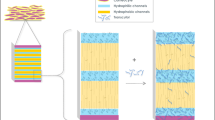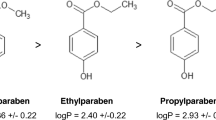Abstract
This work aimed to continue our effort in establishing the feasibility of 3-fluoroamphetamine (also known as PAL-353) to be a transdermal drug candidate by studying the delivery of the base form through the human cadaver skin in lieu of the previously investigated salt form, and for the first time using an EPIDERM™–reconstructed human epidermal model to predict the skin irritation potential of PAL-353, in support of development for a matrix-type transdermal delivery system. Passive and enhanced (with chemical permeation enhancers) transdermal delivery were investigated via in vitro permeation studies that were performed on Franz diffusion cells with dermatomed human cadaver skin. After 24 h, PAL-353 free base revealed high passive permeation of 417.49 ± 30.12, 1577.68 ± 165.41, and 4295.16 ± 264.36 μg/cm2, with applied formulation concentrations of 5.5 (F1), 20 (F2), and 40 (F3) mg/mL, respectively. Oleyl alcohol produced an approximately threefold steady-state flux enhancement at 5% or 10% w/w but may not be needed as the free base alone provided therapeutically relevant permeation. Further, it was predicted that therapeutically relevant delivery would be unlikely to cause skin irritation using the EPIDERM™–reconstructed human epidermal model. In conclusion, the present study further supported the development of PAL-353 transdermal delivery systems.




Similar content being viewed by others
Abbreviations
- HPLC:
-
High-performance liquid chromatography
- UV:
-
Ultraviolet
- FDA:
-
Food and Drug Administration
- LOD:
-
Limit of detection
- LOQ:
-
Limit of quantification
- ICH:
-
The International Council for Harmonization
- PBS:
-
Phosphate buffered saline
- PG:
-
Propylene glycol
- CPE:
-
Chemical permeation enhancer
- MTT:
-
Methyl thiazolyl tetrazoilim
References
Wee S, Anderson KG, Baumann MH, Rothman RB, Blough BE, Woolverton WL. Relationship between the serotonergic activity and reinforcing effects of a series of amphetamine analogs. J Pharmacol Exp Ther. 2005;313(2):848–54.
Wellman PJ, Davis KW, Clifford PS, Rothman RB, Blough BE. Changes in feeding and locomotion induced by amphetamine analogs in rats. Drug Alcohol Depend. 2009;100(3):234–9.
Banks ML, Blough BE, Negus SS. Effects of monoamine releasers with varying selectivity for releasing dopamine/norepinephrine versus serotonin on choice between cocaine and food in rhesus monkeys. Behav Pharmacol. 2011;22(8):824–36.
Negus SS, Baumann MH, Rothman RB, Mello NK, Blough BE. Selective suppression of cocaine- versus food-maintained responding by monoamine releasers in rhesus monkeys: benzylpiperazine, (+)phenmetrazine, and 4-benzylpiperidine. J Pharmacol Exp Ther. 2009;329(1):272–81.
Negus SS, Mello NK. Effects of chronic d-amphetamine treatment on cocaine- and food-maintained responding under a second-order schedule in rhesus monkeys. Drug Alcohol Depend. 2003;70(1):39–52.
Banks ML, Blough BE, Fennell TR, Snyder RW, Negus SS. Effects of phendimetrazine treatment on cocaine vs food choice and extended-access cocaine consumption in rhesus monkeys. Neuropsychopharmacology. 2013;38(13):2698–707.
Grabowski J, Shearer J, Merrill J, Negus SS. Agonist-like, replacement pharmacotherapy for stimulant abuse and dependence. Addict Behav. 2004;29(7):1439–64.
Negus SS, Henningfield J. Agonist medications for the treatment of cocaine use disorder. Neuropsychopharmacology. 2015;40(8):1815–25.
Jiang Y, Murnane KS, Bhattaccharjee SA, Blough BE, Banga AK. Skin delivery and irritation potential of phenmetrazine as a candidate transdermal formulation for repurposed indications. AAPS J. 2019;21(4):70.
Ganti SS, Bhattaccharjee SA, Murnane KS, Blough BE, Banga AK. Formulation and evaluation of 4-benzylpiperidine drug-in-adhesive matrix type transdermal patch. Int J Pharm. 2018;550(1–2):71–8.
Ganti SS, Nguyen HX, Murnane KS, Blough BE, Banga AK. Transdermal formulation of 4-benzylpiperidine for cocaine-use disorder. J Drug Deliv Sci Technol. 2018;47:299–308.
Isaac M, Holvey C. Transdermal patches: the emerging mode of drug delivery system in psychiatry. Ther Adv Psychopharmacol. 2012;2(6):255–63.
Volkow ND, Swanson JM. Variables that affect the clinical use and abuse of methylphenidate in the treatment of ADHD. Am J Psychiatry. 2003 Nov;160(11):1909–18.
de Wit H, Bodker B, Ambre J. Rate of increase of plasma drug level influences subjective response in humans. Psychopharmacology. 1992;107(2–3):352–8.
Ritz MC, Kuhar MJ. Relationship between self-administration of amphetamine and monoamine receptors in brain: comparison with cocaine. J Pharmacol Exp Ther. 1989;248(3):1010–7.
Murnane KS, Winschel J, Schmidt KT, Stewart LM, Rose SJ, Cheng K, et al. Serotonin 2A receptors differentially contribute to abuse-related effects of cocaine and cocaine-induced nigrostriatal and mesolimbic dopamine overflow in nonhuman primates. J Neurosci. 2013;33(33):13367–74.
Murnane KS, Andersen ML, Rice KC, Howell LL. Selective serotonin 2A receptor antagonism attenuates the effects of amphetamine on arousal and dopamine overflow in non-human primates. J Sleep Res. 2013;22(5):581–8.
Howell LL, Murnane KS. Nonhuman primate neuroimaging and the neurobiology of psychostimulant addiction. Ann N Y Acad Sci 2008;1141(1):176–194.
Puri A, Murnane KS, Blough BE, Banga AK. Effects of chemical and physical enhancement techniques on transdermal delivery of 3-fluoroamphetamine hydrochloride. Int J Pharm. 2017;528(1–2):452–62.
Gasior M, Bond M, Malamut R. Routes of abuse of prescription opioid analgesics: a review and assessment of the potential impact of abuse-deterrent formulations. Postgrad Med. 2016;128(1):85–96.
Mastropietro DJ, Omidian H. Current approaches in tamper-resistant and abuse-deterrent formulations. Drug Dev Ind Pharm. 2013;39(5):611–24.
Song Y, Manian M, Fowler W, Korey A, Banga AK. Activated carbon-based system for the disposal of psychoactive medications. Pharmaceutics. 2016;8(4):31.
Williams AC, Barry BW. Penetration enhancers. Adv Drug Deliv Rev. 2004;56(5):603–18.
Ibrahim SA, Li SK. Efficiency of fatty acids as chemical penetration enhancers: mechanisms and structure enhancement relationship. Pharm Res. 2010;27(1):115–25.
Naik A, Pechtold LARMRM, Potts RO, Guy RH. Mechanism of oleic acid-induced skin penetration enhancement in vivo in humans. J Control Release. 1995;37(3):299–306.
Cooper ER. Increased skin permeability for lipophilic molecules. J Pharm Sci. 1984;73(8):1153–6.
Gao S, Singh J. Effect of oleic acid/ethanol and oleic acid/propylene glycol on the in vitro percutaneous absorption of 5-fluorouracil and tamoxifen and the macroscopic barrier property of porcine epidermis. Int J Pharm. 1998;165(1):45–55.
Francoeur ML, Golden GM, Potts RO. Oleic acid: its effects on stratum corneum in relation to (trans)dermal drug delivery. Pharm Res An Off J Am Assoc Pharm Sci. 1990;7(6):621–7.
Kalluri H, Banga AK. Transdermal delivery of proteins. AAPS PharmSciTech. 2011;12(1):431–41.
Banga AK. Transdermal and intradermal delivery of therapeutic agents: application of physical technologies. Boca Raton, Florida: CRC press; 2011.
Elias PM. Epidermal lipids, barrier function, and desquamation. J Invest Dermatol. 1983;80(s6):44s–9s.
Approved drug products with therapeutic equivalence evaluations (orange book) | FDA [Internet]. [cited 2019 Jun 16]. Available from: https://www.fda.gov/drugs/drug-approvals-and-databases/approved-drug-products-therapeutic-equivalence-evaluations-orange-book
Bukstein OG. Transdermal methylphenidate system: old wine in a new bottle. Expert Opin Drug Metab Toxicol. 2009;5(6):661–5.
Zakeri-Milani P, Islambulchilar Z, Majidpour F, Jannatabadi E, Lotfpour F, Valizadeh H. A study on enhanced intestinal permeability of clarithromycin nanoparticles. Brazilian J Pharm Sci. 2014;50(1):121–9.
Murthy SN, Sen A, Zhao Y-L, Hui SW. pH influences the postpulse permeability state of skin after electroporation. J Control Release. 2003;93(1):49–57.
Bakshi P, Jiang Y, Nakata T, Akaki J, Matsuoka N, Banga AK. Formulation development and characterization of nanoemulsion-based formulation for topical delivery of heparinoid. J Pharm Sci. 2018;107(11):2883–90.
Jiang Y, Ray A, Junaid MSA, Bhattaccharjee SA, Kelley K, Banga AK, et al. The pharmacokinetics of 3-fluoroamphetamine following delivery using clinically relevant routes of administration. Drug Deliv Transl Res. 2019:1–11.
Davies DJ, Ward RJ, Heylings JR. Multi-species assessment of electrical resistance as a skin integrity marker for in vitro percutaneous absorption studies. Toxicol Vitr. 2004;18(3):351–8.
Southwell D, Barry BW, Woodford R. Variations in permeability of human skin within and between specimens. Int J Pharm. 1984;18(3):299–309.
Test No. 439: In vitro skin irritation - reconstructed human epidermis test method. OECD; 2013. (OECD Guidelines for the Testing of Chemicals, Section 4).
Abd E, Yousef SA, Pastore MN, Telaprolu K, Mohammed YH, Namjoshi S, et al. Skin models for the testing of transdermal drugs. Clin Pharmacol Adv Appl. 2016;8:163–76.
Squillante E, Needham T, Maniar A, Kislalioglu S, Zia H. Codiffusion of propylene glycol and dimethyl isosorbide in hairless mouse skin. Baseline. 1998;46:265–71.
Wiedersberg S, Guy RH. Transdermal drug delivery: 30+ years of war and still fighting! J Control Release. 2014;190:150–6.
Johnson ME, Mitragotri S, Patel A, Blankschtein D, Langer R. Synergistic effects of chemical enhancers and therapeutic ultrasound on transdermal drug delivery. J Pharm Sci. 1996;85(7):670–9.
Mitragotri S, Johnson ME, Blankschtein D, Langer R. An analysis of the size selectivity of solute partitioning, diffusion, and permeation across lipid bilayers. Biophys J. 1999;77(3):1268–83.
Mitragotri S. Effect of bilayer disruption on transdermal transport of low-molecular weight hydrophobic solutes. Pharm Res. 2001;18(7):1018–23.
Lee PJ, Ahmad N, Langer R, Mitragotri S, Prasad SV. Evaluation of chemical enhancers in the transdermal delivery of lidocaine. Int J Pharm. 2006;308(1–2):33–9.
Transdermal drug delivery systems: the skinny on cutaneous reactions [Internet]. [cited 2019 Oct 14]. Available from: https://www.pharmacytimes.com/publications/issue/2013/may2013/transdermal-drug-delivery-systems-the-skinny-on-cutaneous-reactions
Manian M, Madrasi K, Chaturvedula A, Banga AK. Investigation of the dermal absorption and irritation potential of sertaconazole nitrate anhydrous gel. Pharmaceutics. 2016;
Sivaraman A, Ganti SS, Nguyen HX, Birk G, Wieber A, Lubda D, et al. Development and evaluation of a polyvinyl alcohol based topical gel. J Drug Deliv Sci Technol. 2017;39:210–6.
Gao X, Patel MG, Bakshi P, Sharma D, Banga AK. Enhancement in the transdermal and localized delivery of Honokiol through breast tissue. AAPS PharmSciTech. 2018;19(8):3501–11.
Romita P, Foti C, Calogiuri G, Cantore S, Ballini A, Dipalma G, et al. Contact dermatitis due to transdermal therapeutic systems: a clinical update. Acta Bio Medica Atenei Parm. 2019;90(1):5–10.
Ananthapadmanabhan KP, Lips A, Vincent C, Meyer F, Caso S, Johnson A, et al. pH-induced alterations in stratum corneum properties. Int J Cosmet Sci. 2003;25(3):103–12.
Funding
The current project was funded by grant # GRA.VL17.11 (Murnane and Banga—Multiple Principal Investigators) by Georgia Research Alliance based in Atlanta, Georgia, and by grant # DA12970 (Blough—Principal Investigator) by the National Institute on Drug Abuse.
Author information
Authors and Affiliations
Corresponding author
Ethics declarations
Conflict of Interest
The authors declare that they have no conflicts of interest.
Additional information
Publisher’s Note
Springer Nature remains neutral with regard to jurisdictional claims in published maps and institutional affiliations.
Rights and permissions
About this article
Cite this article
Jiang, Y., Murnane, K.S., Blough, B.E. et al. Transdermal Delivery of the Free Base of 3-Fluoroamphetamine: In Vitro Skin Permeation and Irritation Potential. AAPS PharmSciTech 21, 109 (2020). https://doi.org/10.1208/s12249-020-01649-5
Received:
Accepted:
Published:
DOI: https://doi.org/10.1208/s12249-020-01649-5




